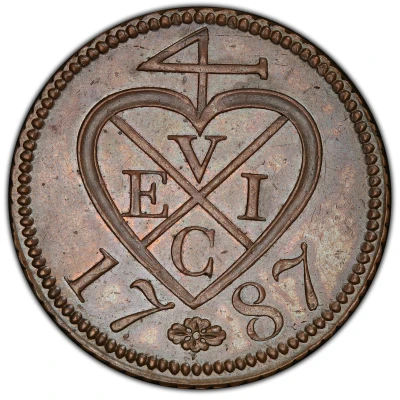


3 Keping 1202 1787 Pattern
1202 (1788) year| Gold plated copper | 9.72 g | 29 mm |
| Issuer | Sumatra (British East Indies) |
|---|---|
| Type | Pattern |
| Year | 1202 (1788) |
| Calendar | Islamic (Hijri) |
| Value | 3 Kepings (3⁄400) |
| Currency | Dollar (1783-1824) |
| Composition | Gold plated copper |
| Weight | 9.72 g |
| Diameter | 29 mm |
| Thickness | 1.9 mm |
| Shape | Round |
| Technique | Milled |
| Orientation | Coin alignment ↑↓ |
| Demonetized | Yes |
| Updated | 2024-10-04 |
| Numista | N#393307 |
|---|---|
| Rarity index | 95% |
Reverse
Arabic numbers and Jawi script denomination.
Script: Arabic
Lettering:
۳
تيݢ كفڠ
١٢٠٢
Unabridged legend:
3
Tiga keping
1202
Translation:
Three keping
AH 1202
Engraver: Jean-Pierre Droz
Edge
Reeding slanted
Comment
Produced by Matthew Boulton as one of a series of test pieces; they are some of the first coins produced using James Watt's steam engine. This particular piece is one of Boulton's patterns, experimenting at his famous Soho mint he produced pattern pieces experimenting with techniques such as silver plate, ormolu (gilt) and other arts. This coin is an example of a copper 3 keping gilded in .916.7 gold, originally issued for the East India Company for use in Bencoolen on the island of Sumatra. Boulton also produced similar variants of the 1 and 2 keping coins dated the same year, later moving on to produce the famous British copper coinage of 1797. It is also believed that some of these experimental coins were produced for many years after 1787 by Matthew Boulton as gifts or awards. His portrait was later featured on the British £50 note as an icon of the first industrial revolution.
Interesting fact
One interesting fact about the Pattern 3 Keping 1202 (1787) Pattern 1202 (1788) from Sumatra (British East Indies) made of Gold plated copper weighing 9.72 g is that it is a rare and unique coin that was minted during the British East India Company's rule in Sumatra, Indonesia. It is a pattern coin, meaning that it was minted as a trial or sample coin, and not intended for circulation. The coin's design features a combination of Islamic and European motifs, reflecting the cultural exchange and influence of the British East India Company in the region.



